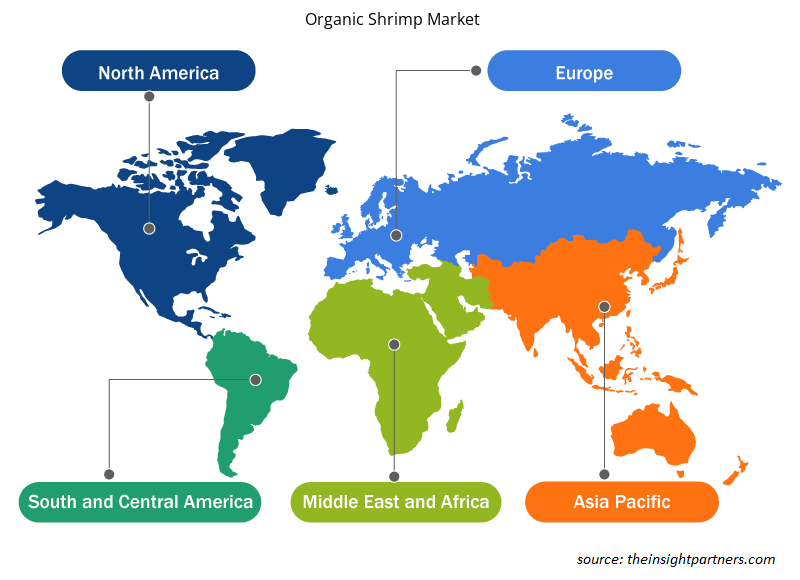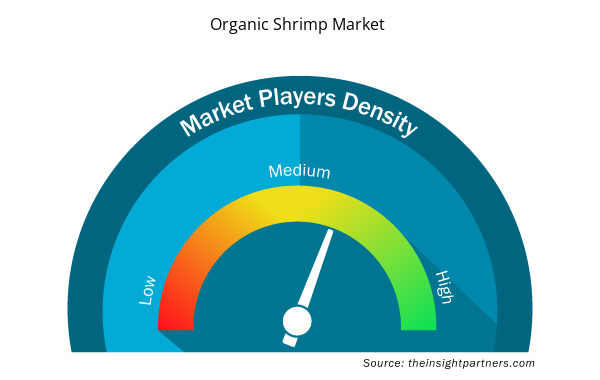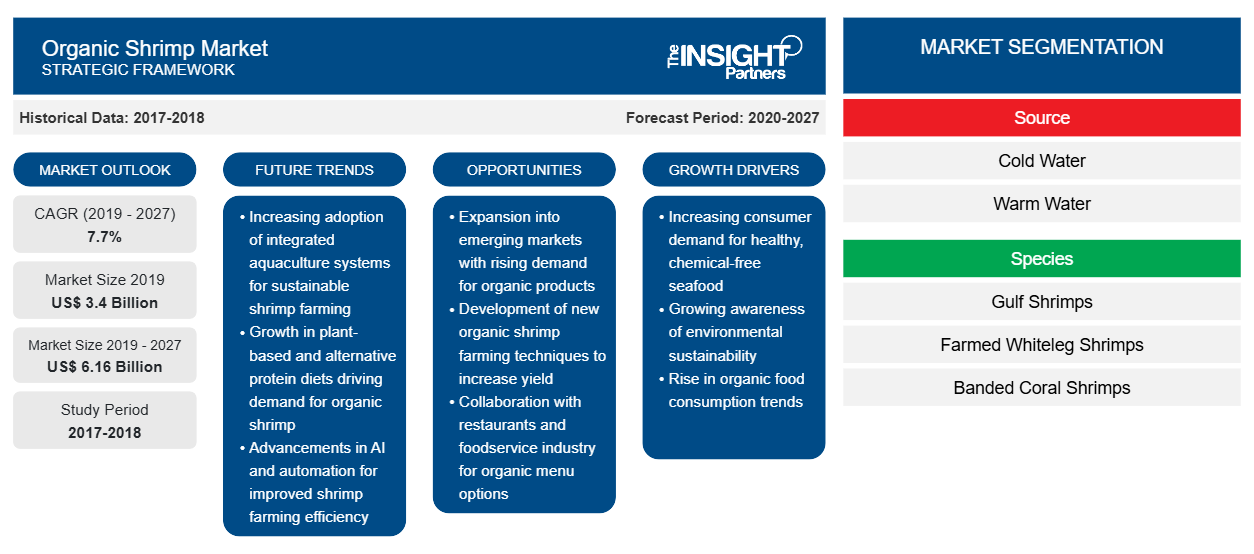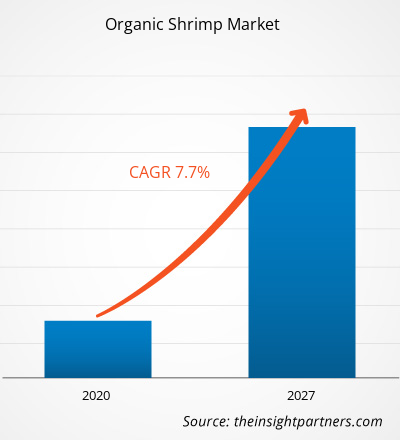2019 年有机虾市场价值为 34 亿美元,预计到 2027 年将达到 61.6 亿美元;预计预测期内复合年增长率为 7.7%。
对经过认证的有机食品的需求出现了前所未有的增长,而海鲜等有机食品生产的新领域也越来越受欢迎。关于食品法典委员会,有机水产养殖是指促进和加强生物多样性、生物循环和生物活动的生态生产管理系统的生产过程和实践。它基于对农场外投入的最低限度使用以及恢复、维护和加强物种多样性和生态和谐的整体管理实践。更广泛地说,有机农业的主要目标是优化相互依存的土壤生命、植物、动物和人类群落的健康和生产力。
目前,由于人们越来越意识到有机虾的健康益处,亚太地区占据了全球有机虾市场的最大份额。该地区有孟加拉国、印度、越南、马来西亚、印度尼西亚和菲律宾等国家,这些国家是全球有机虾的主要出口国。此外,政府扩大有机虾业务的支持举措是支持该地区有机虾市场增长的主要因素之一。2019 年,亚太地区占总市场份额的 52.8%。在市场上运营的公司有机会扩大其在亚太地区的业务,以获得显著的市场份额。
最近的 COVID-19 疫情也使整个湿货市场受到众多政府部门的严格审查。感染的蔓延也导致零售消费者对湿货市场商品的需求有限。此外,许多国家实施的全国封锁严重影响了整个物流和供应链活动。然而,亚太地区的有机虾市场受到了 COVID-19 疫情的综合影响。例如,印度对湿货市场商品和产品的需求下降,导致虾价格下跌,原因是出口机会有限。而印尼市场对虾的需求几乎没有受到影响,由于国际出口暴跌,供应充足,价格大幅下跌。中国已成为仅次于美国的第二大虾进口国,疫情爆发后对虾的需求也略有下降。然而,由于在进口虾中检测到病毒,该国确实对部分拉丁美洲国家出口的虾实施了进口限制
定制此报告以满足您的需求
您可以免费定制任何报告,包括本报告的部分内容、国家级分析、Excel 数据包,以及为初创企业和大学提供优惠和折扣
- 获取此报告的关键市场趋势。这个免费样品将包括数据分析,从市场趋势到估计和预测。
市场洞察
扩大适用范围
由于大多数水产养殖和海洋食品富含多种蛋白质、营养素、矿物质和其他关键氨基酸,因此它们除了消费外,在商业应用方面也具有多种益处。同样,虾也因其丰富的蛋白质和营养素而成为多种矿物质、蛋白质、营养素和欧米茄脂肪酸的丰富来源。例如,虾通常以其低热量含量而闻名,并且每 84 克虾中含有多种营养素,如碘、欧米茄-3 脂肪酸、维生素 B12、铁、锌、磷等。除了在食品工业中具有相当广泛的用途外,虾在化妆品、制药和其他行业中也具有广泛的商业应用范围。例如,废弃虾的科学家已经能够从虾壳中提取出一种特殊的聚合物,这种聚合物能够广泛应用于众多个人护理和其他工业产品配方中。而虾中存在的线性多糖化合物壳聚糖在医药产品中具有广泛的应用范围,有利于治疗高胆固醇、肾衰竭、血压和人类的许多其他治疗。除此之外,虾中还含有丰富的抗氧化剂,如类胡萝卜素,也称为虾青素,在减少多种慢性疾病、减少心脏病发作和防止脑细胞损伤方面具有巨大的应用价值。因此,科学家们正在不断探索从虾中提取的各种其他益处的其他商业应用,并有望在未来几年推动市场的增长。
来源洞察
根据来源,有机虾市场分为冷水虾和温水虾。2019 年,冷水虾在全球有机虾市场中占有最大份额。冷水虾主要以浮游动物为食,通常在水底生活约八年。冷水虾通常以冷冻和进口的形式用于餐馆食用,也供零售业个人新鲜食用。冷水虾以其丰富的 omega-3 脂肪酸以及取决于其种类的各种其他营养素而闻名。冷水虾通常适合 0-8 摄氏度的水温,并在六个月内快速生长。冷水虾中最常见的品种是北极甜虾,广泛分布于北美和欧洲地区。
物种洞察
有机虾市场根据种类分为海湾虾、养殖白腿虾、带状珊瑚虾、皇家红虾和其他虾种。2019 年,养殖白腿虾占据了有机虾市场的主导地位。养殖白腿虾是世界上最常见和最受欢迎的虾种之一。养殖白腿虾的其他常用名称是太平洋白虾、大虾或虎虾。这种虾的主要生产国包括巴西、印度、菲律宾、秘鲁、中国、泰国、马来西亚、美国和印度尼西亚等几个国家。养殖白腿虾呈半透明的白色,通常会与白色的墨西哥湾虾混淆。然而,根据虾饲料、水的浑浊度和基质,虾也会呈现出不同的色带,包括绿色、棕色、红色、灰色和横向色带。此外,养殖白对虾是亚洲贸易量最大的水产养殖商品之一,并且由于其在全球主要国家广受欢迎和生产,继续占据全球市场主导地位。因此,养殖白对虾预计将在未来几年为市场参与者提供大量商机。
应用程序洞察
根据应用,有机虾市场分为食品、药品、化妆品等。2019 年,食品领域占据了有机虾市场的主导地位。由于虾在海鲜类别中广受欢迎,并在许多文化中消费,食品行业仍然是虾应用领域无可争议的市场领导者。根据食品或饮料的性质,虾可以作为新鲜或冷冻虾产品食用,在寿司店中广受欢迎。在零售食品行业,冷冻虾是全年最常见的各种虾类产品形式。由于其营养丰富、蛋白质含量高且热量低,它们在国际市场的不同食品行业垂直领域获得了前所未有的欢迎。尽管无论来源如何,虾都受到广大群众的欢迎,但最近人们的生活方式倾向于健康的饮食习惯和做法,这刺激了对有机虾的需求,尤其是在美国和西欧国家。
Cooke Inc.、Nippon Suisan Kaisha, Ltd. 等是全球有机虾市场的主要参与者。这些公司正在实施新产品开发和并购战略,以扩大客户群并在全球范围内获得显著的市场份额,这反过来又使参与者能够在全球范围内保持其品牌名称。
有机虾市场区域洞察
Insight Partners 的分析师已详细解释了预测期内影响有机虾市场的区域趋势和因素。本节还讨论了北美、欧洲、亚太地区、中东和非洲以及南美和中美洲的有机虾市场细分和地理位置。

- 获取有机虾市场的区域具体数据
有机虾市场报告范围
| 报告属性 | 细节 |
|---|---|
| 2019 年市场规模 | 34亿美元 |
| 2027 年市场规模 | 61.6亿美元 |
| 全球复合年增长率(2019 - 2027) | 7.7% |
| 史料 | 2017-2018 |
| 预测期 | 2020-2027 |
| 涵盖的领域 | 按来源
|
| 覆盖地区和国家 | 北美
|
| 市场领导者和主要公司简介 |
|
市场参与者密度:了解其对商业动态的影响
有机虾市场正在快速增长,这得益于终端用户需求的不断增长,而这些需求又源于消费者偏好的不断变化、技术进步以及对产品优势的认识不断提高等因素。随着需求的增加,企业正在扩大其产品范围,进行创新以满足消费者的需求,并利用新兴趋势,从而进一步推动市场增长。
市场参与者密度是指在特定市场或行业内运营的企业或公司的分布情况。它表明相对于给定市场空间的规模或总市场价值,有多少竞争对手(市场参与者)存在于该市场空间中。
在有机虾市场运营的主要公司有:
- 卜蜂食品有限公司
- 海林食品有限公司
- 丸羽日朗株式会社
- 蓝星海产有限公司(蓝雪食品有限公司)
- Clover Leaf Seafoods 家族
免责声明:上面列出的公司没有按照任何特定顺序排列。

- 获取有机虾市场顶级关键参与者概览
报告亮点
- 全球有机虾市场不断发展的行业趋势有助于参与者制定有效的长期战略
- 发达市场和发展中市场采用的业务增长战略
- 2017 年至 2027 年全球有机虾市场定量分析
- 各行业对全球有机虾的需求估计
- PEST 分析可说明行业内买家和供应商预测市场增长的有效性
- 了解竞争激烈的市场形势和全球有机虾需求的最新发展
- 市场趋势和前景以及推动和抑制全球有机虾市场增长的因素
- 通过了解支撑全球有机虾市场增长商业利益的策略来做出决策
- 全球有机虾市场各节点规模
- 全球有机虾市场的详细概述和细分,以及该行业的动态
- 全球有机虾市场各地区规模及增长机遇
全球有机虾市场 – 按来源
- 冷水
- 温水
全球有机虾市场,作者
物种
- 墨西哥湾虾
- 养殖南美白对虾
- 带状珊瑚虾
- 皇家红虾
- 其他的
全球有机虾市场,作者
应用
- 食物
- 制药
- 化妆品
- 其他的
公司简介
- 卜蜂食品有限公司
- 海林食品有限公司
- 丸羽日朗株式会社
- 蓝星海产有限公司(蓝雪食品有限公司)
- Clover Leaf Seafoods 家族
- 日本水产株式会社
- 皇家格陵兰公司
- 库克水产养殖
- Seacore 海鲜公司
- 奥玛莎公司
- 历史分析(2 年)、基准年、预测(7 年)及复合年增长率
- PEST 和 SWOT 分析
- 市场规模价值/数量 - 全球、区域、国家
- 行业和竞争格局
- Excel 数据集



Report Coverage
Revenue forecast, Company Analysis, Industry landscape, Growth factors, and Trends

Segment Covered
This text is related
to segments covered.

Regional Scope
North America, Europe, Asia Pacific, Middle East & Africa, South & Central America

Country Scope
This text is related
to country scope.
Trends and growth analysis reports related to Food and Beverages : READ MORE..
The List of Companies - Organic Shrimp Market
- Charoen Pokphand Foods PCL
- High Liner Foods Incorporated
- Maruha Nichiro Corporation
- BLUE STAR SEAFOOD CO. LTD. (Blue Snow Food Co, Ltd.)
- The Clover Leaf Seafoods Family
- Nippon Suisan Kaisha, Ltd
- Royal Greenland A/S
- Cooke Aquaculture
- Seacore Seafood Inc
- Omarsa S.A.
The Insight Partners performs research in 4 major stages: Data Collection & Secondary Research, Primary Research, Data Analysis and Data Triangulation & Final Review.
- Data Collection and Secondary Research:
As a market research and consulting firm operating from a decade, we have published and advised several client across the globe. First step for any study will start with an assessment of currently available data and insights from existing reports. Further, historical and current market information is collected from Investor Presentations, Annual Reports, SEC Filings, etc., and other information related to company’s performance and market positioning are gathered from Paid Databases (Factiva, Hoovers, and Reuters) and various other publications available in public domain.
Several associations trade associates, technical forums, institutes, societies and organization are accessed to gain technical as well as market related insights through their publications such as research papers, blogs and press releases related to the studies are referred to get cues about the market. Further, white papers, journals, magazines, and other news articles published in last 3 years are scrutinized and analyzed to understand the current market trends.
- Primary Research:
The primarily interview analysis comprise of data obtained from industry participants interview and answers to survey questions gathered by in-house primary team.
For primary research, interviews are conducted with industry experts/CEOs/Marketing Managers/VPs/Subject Matter Experts from both demand and supply side to get a 360-degree view of the market. The primary team conducts several interviews based on the complexity of the markets to understand the various market trends and dynamics which makes research more credible and precise.
A typical research interview fulfils the following functions:
- Provides first-hand information on the market size, market trends, growth trends, competitive landscape, and outlook
- Validates and strengthens in-house secondary research findings
- Develops the analysis team’s expertise and market understanding
Primary research involves email interactions and telephone interviews for each market, category, segment, and sub-segment across geographies. The participants who typically take part in such a process include, but are not limited to:
- Industry participants: VPs, business development managers, market intelligence managers and national sales managers
- Outside experts: Valuation experts, research analysts and key opinion leaders specializing in the electronics and semiconductor industry.
Below is the breakup of our primary respondents by company, designation, and region:

Once we receive the confirmation from primary research sources or primary respondents, we finalize the base year market estimation and forecast the data as per the macroeconomic and microeconomic factors assessed during data collection.
- Data Analysis:
Once data is validated through both secondary as well as primary respondents, we finalize the market estimations by hypothesis formulation and factor analysis at regional and country level.
- Macro-Economic Factor Analysis:
We analyse macroeconomic indicators such the gross domestic product (GDP), increase in the demand for goods and services across industries, technological advancement, regional economic growth, governmental policies, the influence of COVID-19, PEST analysis, and other aspects. This analysis aids in setting benchmarks for various nations/regions and approximating market splits. Additionally, the general trend of the aforementioned components aid in determining the market's development possibilities.
- Country Level Data:
Various factors that are especially aligned to the country are taken into account to determine the market size for a certain area and country, including the presence of vendors, such as headquarters and offices, the country's GDP, demand patterns, and industry growth. To comprehend the market dynamics for the nation, a number of growth variables, inhibitors, application areas, and current market trends are researched. The aforementioned elements aid in determining the country's overall market's growth potential.
- Company Profile:
The “Table of Contents” is formulated by listing and analyzing more than 25 - 30 companies operating in the market ecosystem across geographies. However, we profile only 10 companies as a standard practice in our syndicate reports. These 10 companies comprise leading, emerging, and regional players. Nonetheless, our analysis is not restricted to the 10 listed companies, we also analyze other companies present in the market to develop a holistic view and understand the prevailing trends. The “Company Profiles” section in the report covers key facts, business description, products & services, financial information, SWOT analysis, and key developments. The financial information presented is extracted from the annual reports and official documents of the publicly listed companies. Upon collecting the information for the sections of respective companies, we verify them via various primary sources and then compile the data in respective company profiles. The company level information helps us in deriving the base number as well as in forecasting the market size.
- Developing Base Number:
Aggregation of sales statistics (2020-2022) and macro-economic factor, and other secondary and primary research insights are utilized to arrive at base number and related market shares for 2022. The data gaps are identified in this step and relevant market data is analyzed, collected from paid primary interviews or databases. On finalizing the base year market size, forecasts are developed on the basis of macro-economic, industry and market growth factors and company level analysis.
- Data Triangulation and Final Review:
The market findings and base year market size calculations are validated from supply as well as demand side. Demand side validations are based on macro-economic factor analysis and benchmarks for respective regions and countries. In case of supply side validations, revenues of major companies are estimated (in case not available) based on industry benchmark, approximate number of employees, product portfolio, and primary interviews revenues are gathered. Further revenue from target product/service segment is assessed to avoid overshooting of market statistics. In case of heavy deviations between supply and demand side values, all thes steps are repeated to achieve synchronization.
We follow an iterative model, wherein we share our research findings with Subject Matter Experts (SME’s) and Key Opinion Leaders (KOLs) until consensus view of the market is not formulated – this model negates any drastic deviation in the opinions of experts. Only validated and universally acceptable research findings are quoted in our reports.
We have important check points that we use to validate our research findings – which we call – data triangulation, where we validate the information, we generate from secondary sources with primary interviews and then we re-validate with our internal data bases and Subject matter experts. This comprehensive model enables us to deliver high quality, reliable data in shortest possible time.


 获取此报告的免费样本
获取此报告的免费样本